Offline Mobile Based Library Circulation System Report 2022
Developing a mobile-based library circulation system that allows library staff to check in/check out items using a mobile phone or tablet with a local SQLLite database. The system should also be able to scan barcodes on items and send the information to the central database server when the network connection is available.
Added on 2022-10-11
Offline Mobile Based Library Circulation System Report 2022
Developing a mobile-based library circulation system that allows library staff to check in/check out items using a mobile phone or tablet with a local SQLLite database. The system should also be able to scan barcodes on items and send the information to the central database server when the network connection is available.
Added on 2022-10-11
SYSTEM
[Document subtitle]
[DATE]
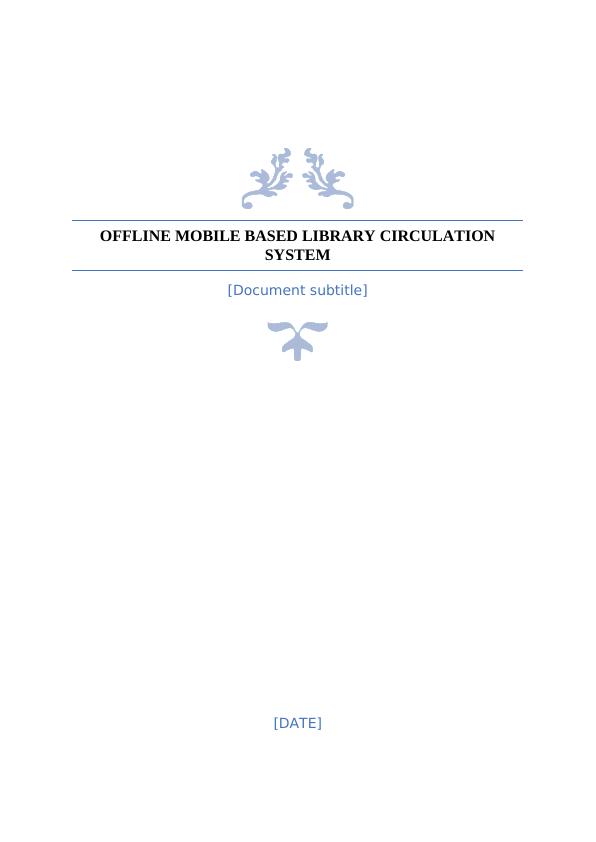

CHAPTER ONE....................................................................................................... 4
1. INTRODUCTION............................................................................................... 4
1.1. Background................................................................................................. 4
1.1.1 Existing Problem.................................................................................... 9
1.1.2 Situation............................................................................................. 10
1.2 Motivation................................................................................................. 11
1.3 Project Aim............................................................................................... 11
1.4 Project Objectives....................................................................................... 11
CHAPTER TWO.................................................................................................... 13
2. REQUIREMENT ANALYSIS............................................................................. 13
2.1 Introduction................................................................................................... 13
2.2 Stakeholders................................................................................................... 13
2.3 System Interface.............................................................................................. 14
2.4 User Interface................................................................................................. 17
2.5 Characteristics................................................................................................ 20
2.6 Scope of the System.......................................................................................... 20
2.7 Functional Requirements.................................................................................. 21
2.8 Non-Functional Requirements............................................................................21
CHAPTER THREE................................................................................................. 23
3. RESEARCH/ LITERATURE REVIEW................................................................23
3.1 Introduction................................................................................................... 23
3.2 Library System............................................................................................... 23
3.2.1 Introduction.......................................................................................... 23
3.2.2 MARC21 File Format............................................................................. 27
3.2.3 Scanning Process................................................................................. 31
3.2.4 Conclusion............................................................................................ 31
3.3 Software Development Technologies....................................................................32
3.3.1 Introduction.......................................................................................... 32
3.3.2 Java...................................................................................................... 32
3.3.3 JSON..................................................................................................... 33
3.3.4 MySQL.................................................................................................. 33
3.3.5 Conclusion............................................................................................ 34
CHAPTER FOUR................................................................................................... 36
4 PRODUCT DESIGN.............................................................................................. 36
4.1 Technologies................................................................................................... 36
pg. 2
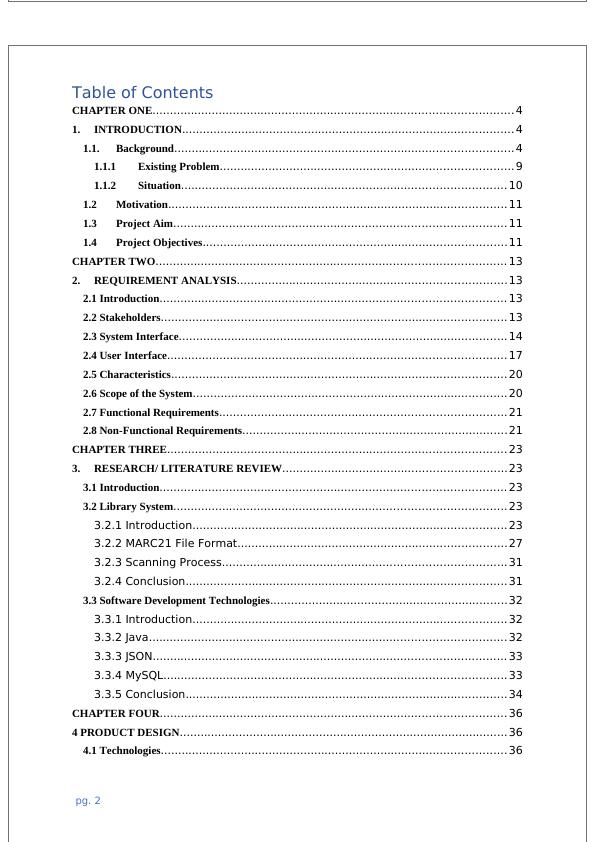
4.3 Data Models................................................................................................... 39
4.4 Security......................................................................................................... 40
CHAPTER FIVE..................................................................................................... 41
5 IMPLEMENTATION............................................................................................ 41
5.1 Interface........................................................................................................ 41
5.2 Technical Details............................................................................................. 42
5.2.1 Scanning Barcode................................................................................. 42
5.2.2 Storing Details...................................................................................... 43
5.2.3 Client-side Technologies.......................................................................43
CHAPTER SIX....................................................................................................... 44
6 TESTING............................................................................................................ 44
CHAPTER SEVEN.................................................................................................. 45
7 PROJECT MANAGEMENT................................................................................... 45
7.1 Schedule......................................................................................................... 45
7.2 Project Deliverables......................................................................................... 46
7.3 Risk Management............................................................................................ 46
7.4 Communication with Client............................................................................... 47
CHAPTER EIGHT.................................................................................................. 48
8 PROJECT EVALUATION..................................................................................... 48
8.1 Software Quality............................................................................................. 48
8.2 Ease of Use..................................................................................................... 48
8.3 Methodology Choice......................................................................................... 49
8.4 Future Improvement........................................................................................ 49
CHAPTER NINE.................................................................................................... 50
9 REFLECTION..................................................................................................... 50
9.1 Achievements.................................................................................................. 50
9.2 Challenges...................................................................................................... 51
9.3 Conclusion..................................................................................................... 52
References and Bibliography..................................................................................... 53
pg. 3
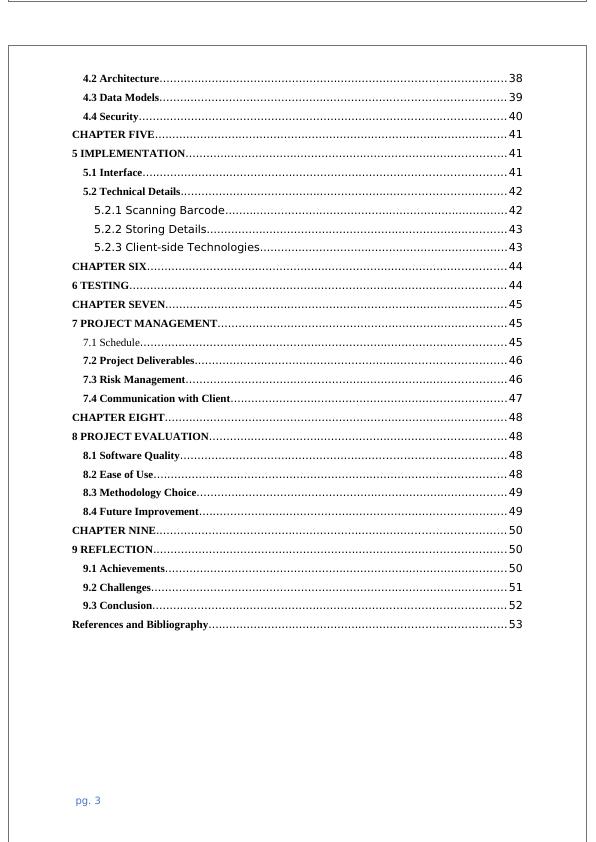
1. INTRODUCTION
This is the very first chapter of the report. The chapter introduces general information about
library management system. In this chapter, the background of library management system
will be discussed in details, the background of the system will be divided into general and
specific background. General background information will discuss all the general information
which pertains library management system from its definitive state. Specific background
information will discuss the topic under investigation which is the library information system
in mobile devices, the background of mobile based library circulation system will be
discussed too. The objectives which are supposed to be achieved will also be outlines as the
project has to achieve the set objectives to be termed as complete and satisfactory project.
The aim purpose or the aim of carrying out the project will also be established in this chapter,
the motivation factor behind getting into researching this particular topic and its benefits that
will come as a result of successfully completing and implementing the project is also
discussed. The statement of the problem which contains the existing problem which
prompted research and implementation of the project is a discussed too.
1.1. Background
A library is a sorted out gathering of data sources which is made available to the
individuals. The library generally contains the data physically or in a digitized
arrangement. In the bygone time frame the entrance was for the most part in the
library room as the innovation grew up the entrance that was made on the web
(Dinesh et al.,2015). Library is a quickly developing life form. The antiquated
strategies to keep up it are never again unique and proficient. For quick recovery and
pg. 4

procedures has turned out to be totally imperative (Neelakandan et al., 2010).
A library is involved the accompanying areas, in light of the administrations
rendered.
i. Acquisition Section: The books requested by various divisions are finished by
the Acquisition area. College book focus is additionally working in this area for
supply of books to the libraries in this college.
ii. Technical Section: To arrange, index, OPAC, Barcode and so forth the
archives of the University Library this segment is working. 2
iii. Circulation Section: This segment gives reports to the individuals and clients
of library for home perusing just as perusing in the library. The archives are
organized on the racks in stacks according to the Dewey Decimal Classification
Scheme.
iv. Periodical Section: To acquire, keep up and orchestrate periodicals
administrations to library individuals. Periodical area furnishes reference
administration as for the necessity of the peruser. Reference area is connected to
periodical segment for accommodation of the Library clients.
v. Databases: Databases like OPAC, CAB-CD ROM abstracting databases,
DELNET online Network Service and so on are accessible for the library
individuals.
vi. Reprographic Section: This Section has two programmed plain paper copiers
and a copying machine through which the administrations of photocopy are given to
the perusers.
pg. 5
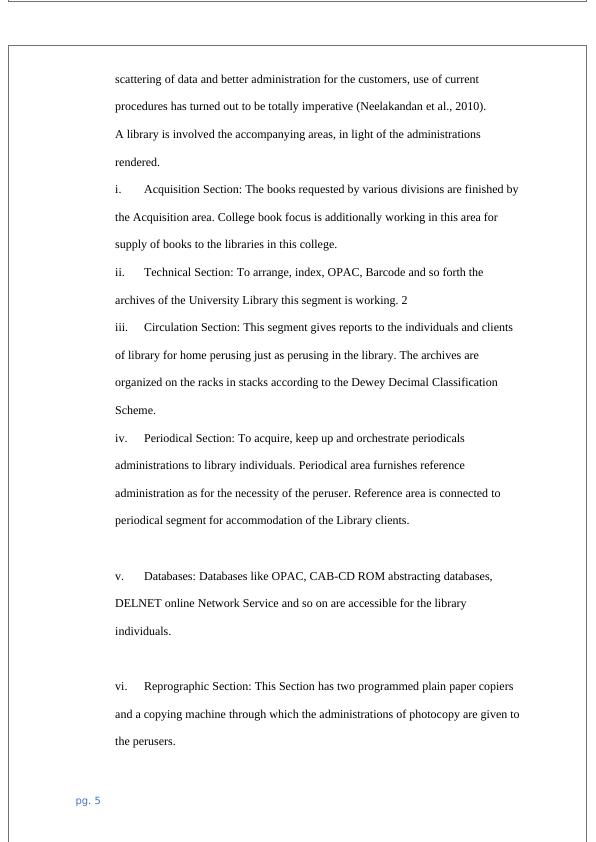
books. Back Volumes and different reports of this Library. The required restricting
apparatus is accessible in this area.
Library the board is a sub-control of institutional administration that spotlights on
explicit issues looked by libraries and library the board experts. Library the
executives envelops typical administration errands just as scholarly opportunity,
against control, and gathering pledges undertakings. Issues looked in library the
board habitually cover those looked in the executives of non-benefit
organizations(Sharma et al.,2005).Library Management System is an application that
pictures library framework which could be commonly little or medium in size. It is
utilized by the bookkeeper to completely deal with the library by the uprightness of
utilizing an automated framework where he/she can record different exchanges like
issue of books, return of books, expansion of new books, expansion of new
understudies and so forth. (Ashutosh and Ashish., 2011). 3 Books and client upkeep
modules are additionally incorporated into this framework which would monitor the
clients utilizing the library and furthermore a point by point portrayal about the
books a library contains. With this automated framework there will be no loss of
book record or part record which by and large happens when a non-electronic
framework is utilized. Moreover, report module is likewise incorporated into Library
Management System (Anon, n.d.). On the off chance that client's position is
administrator, the client can produce various types of reports like arrangements of
clients enrolled, rundown of books, issue and return reports. Every one of these
modules can assist administrator with managing the library with more
accommodation and in a progressively proficient manner when contrasted with
library frameworks which are not automated. Under review as permitted by the
pg. 6
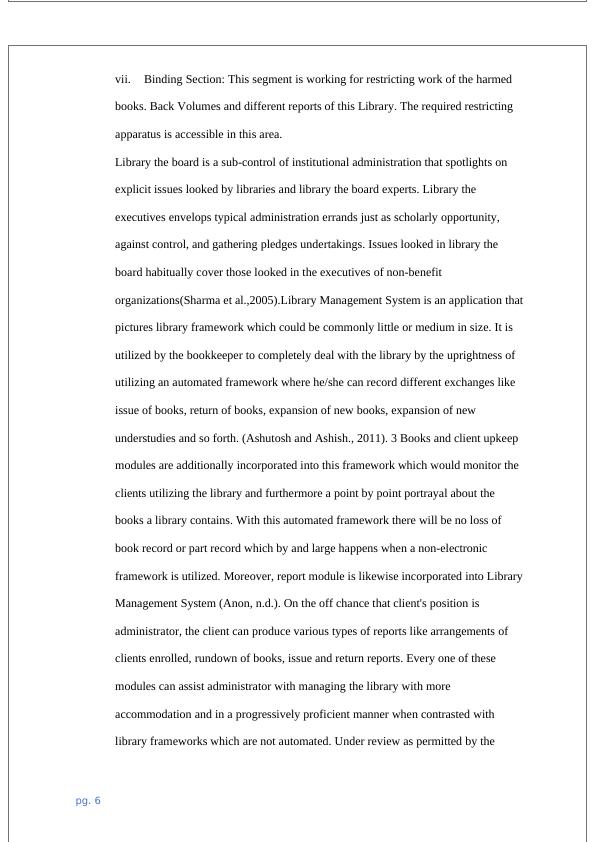
able vital and important in the overall management of the library items. The system
has the following main advantages which includes the ability to increase the staff
available support especially in modernized library facilities, the system has provided
efficiency , it is also easy and most time effective as it saves time by improving the
experience of the user. the management system fro the library under there normal
circumstance, contains the relational database, the graphical user interface also
known as the GUI in its abbreviation format, and the administrator platform. In
most cases for the library systems which are integrated, they have software functions
which are separate and categorized into the programs that are discrete called the
modules, in this, each module is integrated using a unified user interface. This
framework will be created and intended to enable administrator to record each book
exchange to decrease and kill issue of loss of books and documents in the library.
1.1.1 Existing Problem
The main problem which is existing in the current system is the possibility of
having a smooth check in and check out of book by the borrowers and its general
management when the system is down due to network connection. The current
system is networked system which employs the use of internet in processing details
in the library. Sometime network connectivity can be down in such a way that the
system is not in a position to continue processing the check in and check out of
book or its very slow hence making it very difficult to serve the large number of
borrowers available in the facility. This forced the library management to embark
on the manual way of information recording which is time wasting and tedious. A
lot of time is taken in borrowing books or returning the books which have been
pg. 7

End of preview
Want to access all the pages? Upload your documents or become a member.
